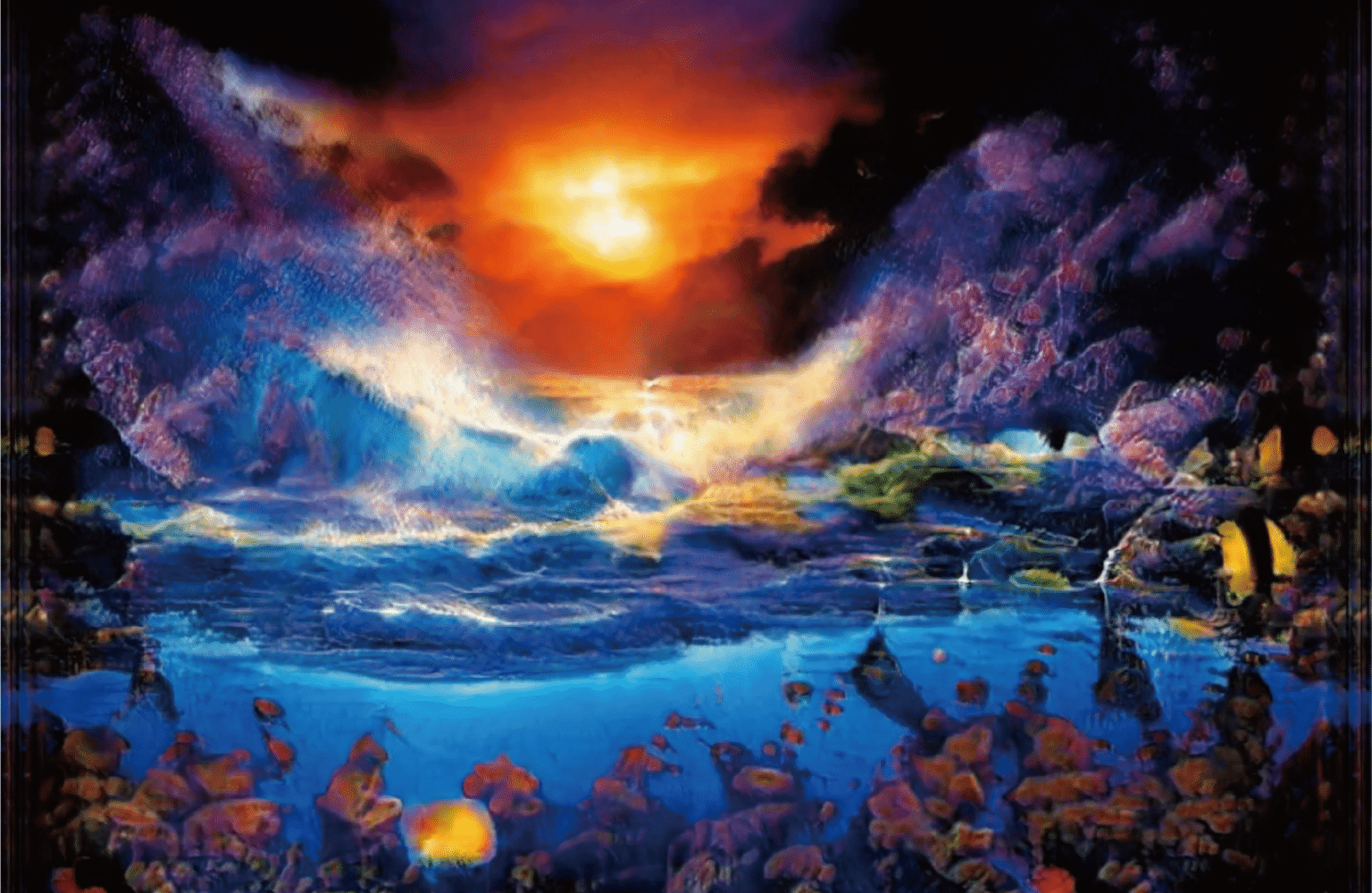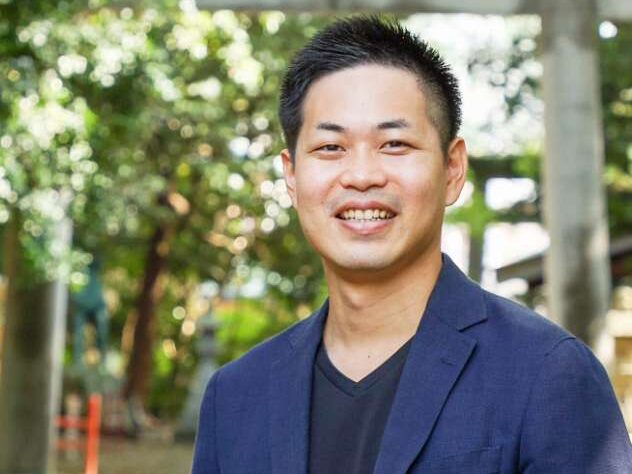Columns

Kinan Art Week Artist Interview: Yuma Kishi
We are pleased to present you with a series of “Artist Interviews” introducing the exhibiting artists of Kinan Art Week.
<Our guest this time>
AI Artist
Yuma Kishi
He sees AI not as a tool to imitate people, but as an alien intelligence from another dimension. He places himself in a parallel relationship with this intelligence and creates his work.
In 2019, he graduated from Tokyo University’s Graduate School of Engineering , and from 2021 he will be studying for a Master’s degree in Inter-media Art at Tokyo University of the Arts.
https://obake2ai.com/
<Interviewer>

Yuto Yabumoto
Kinan Art Week Executive Committee Chair
<Editing>
Kinan Editor by TETAU
https://good.tetau.jp/
<Table of Contents>
1. The world of a commercial painter as read by artificial intelligence
2. Art that connects man and the universe
1. The World of a Commercial Painter as Read by Artificial Intelligence
Yabumoto:
Thank you for your time. Today we would like to talk to you about your work. Thank you very much for your time.
Mr Kishi:
I look forward to working with you.
This work is a brushed up version of a video work I did for a solo exhibition at Blockhouse in Harajuku.
I’m usually interested in how people and non-human intelligence can work together to create artworks. “Utopia” is a work of art that was created by training an artificial intelligence (AI) on over 1000 paintings by a commercial artist.
Yabumoto:
Why “him”?
Mr Kishi:
When Japan was in a bubble economy, I think he was the one who was the window for Japanese people to get involved in art. He was like a star, wasn’t he? As a living artist, most Japanese people have seen his paintings at some point in their lives. That’s one of the reasons why I found this phenomenon so interesting.
Yabumoto:
It took the world by storm for a while.
Mr Kishi:
AI can learn paintings, but it’s all superficial. For example, a painting by Picasso. The concept that Picasso wanted to express is not captured by AI, it’s just an imitation. But I think it’s interesting that “he” can stand on “his” own as a work of art. Perhaps it’s hollow inside. So I think he is a very rare artist who can create a work of art through AI learning.
Yabumoto:
In a good way and a bad way. (laughs)
Mr Kishi:
I made this video because of the commonality and emptiness of his work.
Yabumoto:
So the title “Utopia” seems ironic to me.
Mr Kishi:
When talking about AI, it is sometimes called a dystopian*1 idea. “Utopia” is an ironic response to that, and I thought it would be a good name for “him” because of his easy-going atmosphere.
※1 An anti-ideal world, a dark world. A work that depicts such a world. dystopia (Extract from Kotobank)
Yabumoto:
I see. “Love” and “beauty” have appeared in your previous works. Do they have anything to do with your work?
Mr Kishi:
Love is a concept that runs through my work. But it is not a romantic love, for example, in the realm of art, when I hit something that is not art, I feel that there is a kind of energy that inevitably tries to return to art. I observe it as “love”.
If you can find beauty in an ideal world, that may be a wonderful thing, but I’m interested in how the viewer feels once that ideal thing is destroyed and laid out. Does the act of a non-human being continuing to paint seem banal or aesthetic? That’s what I’m consistently interested in.
2. Art that Connects Man and the Universe
Source: Yuma Kishi HP https://obake2ai.com/
Yabumoto:
Can I ask you how you see AI?
Mr Kishi:
Kevin Kelly published an article in 2016 or so called “AI is what Alien Intelligence is “2 . When I was a student, I was really inspired by that article. It’s had a big influence on my current work.
AI was first born as Artificial Intelligence, something that imitates human intelligence, but it is evolving in a completely different way to human intelligence. It can identify thousands or tens of thousands of photos in a smartphone in an instant, or it can keep monitoring people with a surveillance camera.
In short, the concept of alien intelligence is not about imitating others, but about living as an alien intelligence, collaborating in society. I agree with that idea. When we have parallel intelligence that is different from humans, what should we leave to them, and what is left to us when we have a superior intelligence? I see it as a kind of mirror of humanity.
※2 Reference https://wired.jp/2016/07/06/kk-column-1/
Yabumoto:
So AI is like a relative of humans – is it efficient?
Mr Kishi:
It can be roughly divided into two areas. “Optimisation” and “Extension”.
It can automate and optimise tedious tasks, from those that create statistical models and so on, the so-called big data. The other question is how far we can extend the use of AI to areas where people have been involved. The former is more about efficiency. What I’ve been working on is AI as an extension of the latter.
Yabumoto:
It’s becoming a discussion about the integration of humans and AI, isn’t it.
Mr Kishi:
Rather than integration, I would rather have the AI take my job. I think we’d be happier if they replaced, or substituted in some other way, the non-human activities that we do now.
Yabumoto:
I’ve just intuitively thought that AI is likely to be connected in a Lemma*3 way.
Even without a brain, slime molds are designed to move in an optimal way when eating plants. Kumagusu Minakata sees the world in the slime molds. It is the idea of Kegon, to see the universe in something small. The theme of this year’s Art Week, ‘Seclusion and Openness’, also comes from this idea.
※3 Intuitive (reference Shinichi Nakazawa, “Lemmatology”, https://bookclub.kodansha.co.jp/product?item=0000323958)
Mr Kishi:
It’s non-anthropocentrism. I think that systems engineering is becoming the embodiment of the world as seen by non-humans, rather than the world as seen by humans.
A machine language is not unreadable to humans in the first place. Of course, if you consult the errata, the language becomes human-readable. For the most part, the language that doesn’t need to be read is being communicated inside the computers. That already means that people are not in control .
I like Andy Clarke’s book “Natural-born cyborgs “*4. We are conscious of moving our hands, but we are not aware of the movement of muscle fibres, bones and joints until we move them. I think that if we expand into that area, we don’t have to fear the arrival of the black box intelligence of AI.
※4 Reference: https://www.shunjusha.co.jp/book/9784393323526.html
Yabumoto:
AI is like Logos*5, but it could become a Lemma-like entity that transcends Logos. We can ask ourselves whether this is a “utopia”.
※5 It means the discernment or reason which recognizes and follows universal laws and rules. A basic term in philosophy. (Extract from Kotobank)
Mr Kishi:
We’re really becoming connected, aren’t we? (laughs)
According to quantum physics, our universe is made up of 11 dimensions. It seems that the energy created by the big bang and the energy that exists in this universe are far insufficient. That’s why the multiverse*6 theory is one of the most popular theories. On the other hand, we know that AI is simulating thoughts in a 512-dimensional universe.
When I force these two facts together, I have the feeling that there is a universe apart from the one in which we live (which is engaged in intellectual activities), that is viewing us through the monitor.
※6 A term coined by replacing “uni” (single) with “multi” (many) in universe. It is based on the hypothesis that there may be countless universes, not just the one in which we exist. (Extract from Kotobank)
Yabumoto:
It could be Dainichi Nyorai*7. It is a world where human beings cannot enter. Some people who have studied Kumagusu and art say that art is a passage or a circuit, connecting the human world and Dainichi Nyorai.
It was a very worthwhile time. I would be happy to talk to you again in person.
Thank you very much for your time today.
※7 The name of the Buddha, the root of the universe. (Extract from Kotobank)
